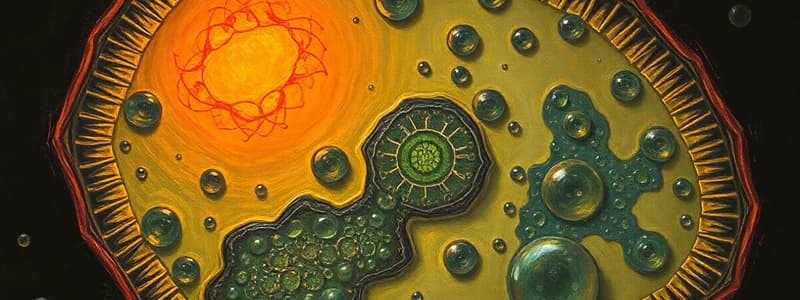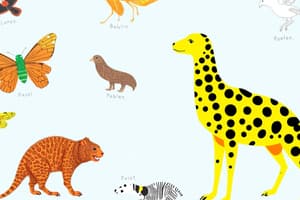Podcast
Questions and Answers
What does the World Health Organization (WHO) define as human health?
What does the World Health Organization (WHO) define as human health?
- A state of complete physical, mental and social well-being. (correct)
- The capability to engage in daily activities without limitations.
- A state of complete mental and emotional well-being.
- The absence of disease or infirmity.
Which at least one characteristic is true of communicable diseases?
Which at least one characteristic is true of communicable diseases?
- They are always present from birth.
- They can be transmitted from one person to another. (correct)
- They are caused by genetic mutations.
- They are caused by environmental toxins.
Which of the following diseases is categorized as communicable?
Which of the following diseases is categorized as communicable?
- Cardiovascular disease
- Parkinson's disease
- Diabetes
- Tuberculosis (correct)
What are pathogens responsible for in terms of disease?
What are pathogens responsible for in terms of disease?
Why might it be unwise to hit someone hard on the back?
Why might it be unwise to hit someone hard on the back?
What is a common misconception about science education among learners?
What is a common misconception about science education among learners?
What is essential for making science education meaningful according to the provided content?
What is essential for making science education meaningful according to the provided content?
Which competencies are highlighted as necessary for success in the 21st century?
Which competencies are highlighted as necessary for success in the 21st century?
What approach is recommended to foster a scientific temper in young learners?
What approach is recommended to foster a scientific temper in young learners?
What does the revision of science textbooks aim to achieve?
What does the revision of science textbooks aim to achieve?
Why is fostering learners' scientific beliefs important?
Why is fostering learners' scientific beliefs important?
Which characteristic is NOT mentioned as part of transversal competencies?
Which characteristic is NOT mentioned as part of transversal competencies?
What outcome is expected from the effective science curriculum?
What outcome is expected from the effective science curriculum?
What is the primary function of the cell membrane?
What is the primary function of the cell membrane?
Which organelle is responsible for protein synthesis?
Which organelle is responsible for protein synthesis?
Which structure is found only in animal cells?
Which structure is found only in animal cells?
What substance fills the nucleus and supports the nucleolus?
What substance fills the nucleus and supports the nucleolus?
What are mitochondria primarily known for?
What are mitochondria primarily known for?
What is the role of the Golgi bodies in the cell?
What is the role of the Golgi bodies in the cell?
Which of the following statements is true about vacuoles in animal cells?
Which of the following statements is true about vacuoles in animal cells?
What is the function of the endoplasmic reticulum?
What is the function of the endoplasmic reticulum?
What is the primary cause of scurvy?
What is the primary cause of scurvy?
Which of the following statements about the scapula is true?
Which of the following statements about the scapula is true?
Which vitamin deficiency is linked to rickets?
Which vitamin deficiency is linked to rickets?
What role does the cerebellum play compared to the cerebrum?
What role does the cerebellum play compared to the cerebrum?
What is the process by which plants produce food?
What is the process by which plants produce food?
What is the primary function of alveoli in the respiratory system?
What is the primary function of alveoli in the respiratory system?
Which of the following diseases is caused by a virus?
Which of the following diseases is caused by a virus?
Which gas is released into the atmosphere as a byproduct of photosynthesis?
Which gas is released into the atmosphere as a byproduct of photosynthesis?
Why were night pilots fed with carrot juice during the Second World War?
Why were night pilots fed with carrot juice during the Second World War?
Which of the following nutrients is a primary macronutrient essential for plant growth?
Which of the following nutrients is a primary macronutrient essential for plant growth?
What is the main purpose of the BCG vaccine?
What is the main purpose of the BCG vaccine?
What typically happens to the water level in a test tube during the photosynthesis experiment?
What typically happens to the water level in a test tube during the photosynthesis experiment?
What are the two categories of plant nutrients?
What are the two categories of plant nutrients?
Why are green plants essential for life on Earth?
Why are green plants essential for life on Earth?
What is the main reason plants exhibit deficiency symptoms?
What is the main reason plants exhibit deficiency symptoms?
Which of the following is NOT considered a primary nutrient?
Which of the following is NOT considered a primary nutrient?
Flashcards are hidden until you start studying
Study Notes
Foreword
- Science is important for the wellbeing of humans.
- Science relies on exploration, inquiry, and investigation.
- Science is often seen as complex and difficult, posing challenges for teaching to young learners.
- It is important to make science learning engaging and link concepts to the real world.
- The revision of science textbooks should align with global views of science and educational philosophies.
- The curriculum should focus on developing scientific skills and fostering scientific literacy.
Animal Cell
- The cell membrane is the outermost layer of the animal cell.
- Cytoplasm is a semi-liquid substance that fills the cell.
- Cell organelles are specialized structures within the cytoplasm.
- The endoplasmic reticulum is a network of membranes that connects the plasma membrane and the nuclear membrane.
- Mitochondria are organelles with double membranes.
- Ribosomes are small organelles found in the cytoplasm or attached to the endoplasmic reticulum.
- Golgi bodies are small vesicles near the nucleus.
- The centrosome is a star-like structure near the nucleus found only in animal cells.
- Vacuoles are large cavities filled with cell sap.
Nucleus
- The nucleus is an oval-shaped organelle in the center of the cytoplasm.
- It is surrounded by a double-layered nuclear membrane.
- Nucleoplasm is a dense semi-fluid substance within the nucleus.
- Nucleoli are small spherical bodies inside the nucleus.
Human as Organism
- Health is a state of complete physical, mental, and social well-being.
- Disease is an abnormal functioning of the body.
- Diseases can be present from birth or acquired during life.
- Communicable diseases are transmitted from one person to another.
- Pathogens are disease-causing organisms.
Communicable Diseases
- Bacteria are present in air, water, soil, and living and non-living things.
- Bacteria cause many diseases, including:
- Tuberculosis
Health and Diseases
- Scurvy can be prevented by eating oranges and lemons, suggesting it is caused by a nutritional deficiency.
- The scapula is not the collar bone, the collar bone is the clavicle.
- Respiration is the process of taking in oxygen and giving out carbon dioxide.
- The spinal nerve arises from the spinal cord, not the brain.
- Measles is caused by a virus, not Rhabdovirus.
- A deficiency of iron causes anemia, not goitre.
Match the Following
- BCG vaccine is used for treating tuberculosis.
- The backbone is the main part of the skeleton that provides support to the ribs at the back.
- Neurons are the smallest units of the nervous system that carry impulses.
- Sperm is a special cell produced in the testes.
- Alveoli are the terminal ends of the respiratory system.
Nutrients for Plants
- Plants require nutrients for growth and development.
- Nutrients are absorbed by plant roots from the soil.
- Nutrients come from decayed plants and animals or fertilizers.
- Plant nutrients are divided into macronutrients and micronutrients.
- Macronutrients are required in large amounts.
- Macronutrients are further divided into primary and secondary nutrients.
- Primary nutrients are essential for plant growth.
- The primary nutrients are nitrogen (N), phosphorus (P), and potassium (K).
Studying That Suits You
Use AI to generate personalized quizzes and flashcards to suit your learning preferences.




